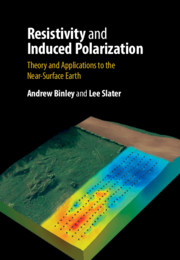Book contents
- Resistivity and Induced Polarization
- Reviews
- Resistivity and Induced Polarization
- Copyright page
- Contents
- Preface
- Acknowledgements
- Symbols
- 1 Introduction
- 2 Electrical Properties of the Near-Surface Earth
- 3 Instrumentation and Laboratory Measurements
- 4 Field-Scale Data Acquisition
- 5 Forward and Inverse Modelling
- 6 Case Studies
- 7 Future Developments
- Appendix A Modelling Tools
- References
- Index
- Plate Section (PDF Only)
3 - Instrumentation and Laboratory Measurements
Published online by Cambridge University Press: 17 December 2020
- Resistivity and Induced Polarization
- Reviews
- Resistivity and Induced Polarization
- Copyright page
- Contents
- Preface
- Acknowledgements
- Symbols
- 1 Introduction
- 2 Electrical Properties of the Near-Surface Earth
- 3 Instrumentation and Laboratory Measurements
- 4 Field-Scale Data Acquisition
- 5 Forward and Inverse Modelling
- 6 Case Studies
- 7 Future Developments
- Appendix A Modelling Tools
- References
- Index
- Plate Section (PDF Only)
Summary
The acquisition of accurate resistivity and induced polarization (IP) measurements requires dedicated laboratory and field-scale instrumentation. Although resistivity measurements are relatively straightforward, IP measurements require sensitive instrumentation and procedures that minimize errors resulting from the sample holder design in the laboratory and from the cables and electrodes in the field. We discuss the basic principles of a laboratory resistivity measurement and then describe the implementation of resistivity measurements at the field-scale, focusing on modern resistivity imaging systems designed to rapidly acquire thousands of measurements on distributed arrays or grids of electrodes. Specific characteristics of the transmitting and receiving electronics, electrodes and cabling are discussed. We address the additional factors that must be considered in the acquisition of meaningful IP measurements. In laboratory measurements, we focus on the critical issue of sample holder design and in the field we focus on strategies to reduce coupling effects between the wiring and the ground. The different ways to quantify the IP effect, commonly termed ‘time domain’ and ‘frequency domain’ measurements, are introduced and derivatives discussed. We also establish the link between the different measures of the IP effect provided by the instrumentation and the intrinsic electrical properties described in Chapter 2.
- Type
- Chapter
- Information
- Resistivity and Induced PolarizationTheory and Applications to the Near-Surface Earth, pp. 100 - 153Publisher: Cambridge University PressPrint publication year: 2020



